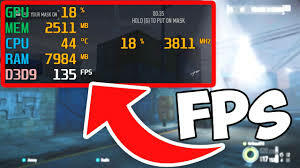Ever felt like your game is stuttering or lagging? It might not be your internet connection acting up. The culprit could be low frames per second (FPS). This is where an FPS tester comes in – your personal performance detective for smooth game play.
What’s the Deal with FPS?
Imagine a flipbook – the faster you flip the pages, the smoother the animation appears. Similarly, in games, FPS refers to the number of images your graphics card can display on your screen every second. Higher FPS translates to smoother visuals and quicker response times, giving you that competitive edge.
Whether you’re a hardcore gamer or a casual enthusiast, an FPS tester can be valuable in several situations:
Tweaking Settings: Ever fiddled with graphics settings in a game but weren’t sure if it actually improved performance? An FPS tester gives you real-time data on how your adjustments impact frame rate. This helps you find the sweet spot between eye candy and smooth game play.
Benchmarking: Wondering how your PC stacks up against others? Benchmarking is the process of running a standardized test and comparing your FPS scores with results from other users with similar hardware. This helps you gauge your PC’s performance and identify potential bottlenecks.
Troubleshooting Lag: Is your game suddenly chugging along? An FPS tester can help pinpoint the problem. By monitoring frame rate fluctuations, you can identify if the issue lies with your hardware, software, or even your internet connection.
The Two Main Types of FPS Testers
FPS testers come in two main flavors:
In-game Overlays: Many modern games have built-in FPS counters that you can activate through the settings menu. These overlays are convenient and unobtrusive, letting you monitor frame rate while you play.
Standalone Applications: Standalone FPS testers offer more features than in-game overlays. They can track frame rate over time, provide detailed graphs for analysis, and even record gameplay footage with FPS data overplayed. These are ideal for in-depth performance analysis and benchmarking.
The Easy Steps to Using an FPS Tester
Using an FPS tester is a breeze, regardless of whether you’re using an in-game overlay or a standalone application:
Fire it Up! Launch your chosen FPS tester. For in-game overlays, activate it through the game’s settings.
Run the Test: If using a standalone application, it might have built-in benchmark tests. Alternatively, run the game you want to test.
Monitor the Magic Numbers: Keep an eye on the frame rate displayed by the tester. Look for dips or spikes that might indicate performance issues.
Analyze and Tweak: Once you have your data, use it to adjust your game settings, troubleshoot issues, or compare results with benchmarks.
The Benefits of Using an FPS Tester
There are several advantages to using an FPS tester:
Smoother Gameplay: Optimize your settings for a tear-free, lag-free gaming experience.
Informed Decisions: Make data-driven choices when tweaking settings or upgrading hardware.
Troubleshooting Powerhouse: Identify performance bottlenecks and diagnose issues quickly.
Bragging Rights: Benchmark your PC and impress your friends with your impressive frame rates (use responsibly!).
Conclusion
An FPS tester is a simple yet powerful tool that can significantly enhance your gaming experience. By understanding frame rate and how to monitor it, you can ensure your games run smoothly and look their absolute best. So, the next time your game stutters, don’t just guess – grab an FPS tester and get to the root of the problem!
Frequently Asked Questions (FAQs)
What’s a good FPS for gaming?
It depends on the game. Generally, 30 FPS is considered playable, 60 FPS is ideal for smooth gameplay, and anything above 120 FPS is great for competitive titles.
Is a higher FPS always better?
Not necessarily. Higher FPS requires more processing power, which can lead to overheating or increased power consumption. Find the balance between visual fidelity and a comfortable frame rate for your system.
Where can I find an FPS tester?
Many games have built-in overlays. Standalone testers are readily available for free or purchase online. Popular options include MSI Afterburner, FRAPS, and Unigine Heaven.
Now, armed with this knowledge, you can go forth and conquer the world of FPS testing! Remember, smooth gameplay is just a click away.
What’s a good FPS for gaming?
It depends on the game. Generally, 30 FPS is considered playable, 60 FPS is ideal for smooth gameplay, and anything above 120 FPS is great for competitive titles.
Is a higher FPS always better?
Not necessarily. Higher FPS requires more processing power, which can lead to overheating or increased power consumption. Find the balance between visual fidelity and a comfortable frame rate for your system.
Where can I find an FPS tester?
Many games have built-in overlays. Standalone testers are readily available for free or purchase online. Popular options include MSI Afterburner, FRAPS, and Unigine Heaven.
Now, armed with this knowledge, you can go forth and conquer the world of FPS testing! Remember, smooth gameplay is just a click away.



